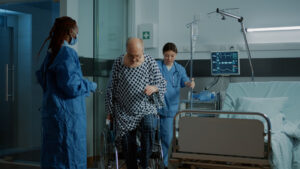To say that Certified Nursing Assistants (CNAs) have a physically demanding job is an understatement. One of the many responsibilities of CNAs involves having to lift and move patients to help them remain comfortable and safe, which makes them more vulnerable to back, knee, and foot problems.
Healthcare workers tend to develop occupational injuries during their careers. One study states that 84.2% of nurses are experiencing low back pain, with 66.7% of them sharing that their pain levels were moderate severity. Meanwhile, another study states that approximately 25 to 30% of nurses experience knee pain. Due to their being on their feet for prolonged periods, healthcare professionals are also prone to developing foot and ankle disorders.
Every day, CNAs work hard to ensure that their patient’s safety and comfort are prioritized, but they should also be empowered to take care of their backs, knees, and feet. Sadly, many CNAs report having missed work due to back pain and occupational injuries every year. In fact, CNAs and orderlies have back and other musculoskeletal injuries roughly three times more than construction laborers do and are the most injured workers of any other occupation.
We list important tips to help keep CNAs’ backs, knees, and feet protected while they work.
Have proper body mechanics
Having proper body mechanics can help keep the back and knees protected. It can also keep the spine safeguarded against abnormal stresses that, over time, can lead to disc and joint issues and injuries.
The Lippincott NursingCenter and Thomson Rivers University provide helpful body mechanics recommendations for nurses and CNAs, including:
· Assessing the weight of the load before lifting and determining if assistance is necessary
· Avoiding stretching and twisting
· Setting the feet in a solid, wide base
· Keeping the head upright and holding the shoulders back
· Keeping the patient close
· Bending the knees and using the momentum from the legs (not the back) to move or lift the patient
· Facing the direction of the movement
· Don’t twist; pivot instead
· When pushing, place one leg forward. When pulling, move one leg back
· Working together with colleagues, including those in other disciplines, such as physical therapy
Use technology to move patients
Manually moving and lifting patients can increase the risk of injury. CNAs can use devices and technology to lift and move patients safely. These patient-lift devices are typically categorized as total assist equipment, moderate assist equipment, or lateral transfer devices.
Do strength-training and mobility exercises
To keep injuries at bay and improve their range of motion, CNAs need to strengthen the muscles that support their core, backs, knees, and ankles. Despite having very busy and demanding workdays, CNAs should still squeeze in a few minutes of their day to do strength-training and mobility exercises. Aside from gaining strength and flexibility, exercising also has other great benefits, including reducing stress and improving cognitive function.
Maintain a healthy weight
People with excess weight are more susceptible to knee pain, injury, and arthritis. An extra 10 pounds of weight can add 30 to 60 pounds of pressure on your knees and lower body joints. The extra weight puts extra pressure on the knees, which can cause pain and inflammation.
Get a good pair of shoes
CNAs need comfortable shoes that can help support their feet, ankles, knees, and legs as they move and stand throughout their shifts. Choose shoes that have good shock absorption, cushioning, and arch support. Ensure that the shoes you get also have good traction to avoid slips and tumbles.







